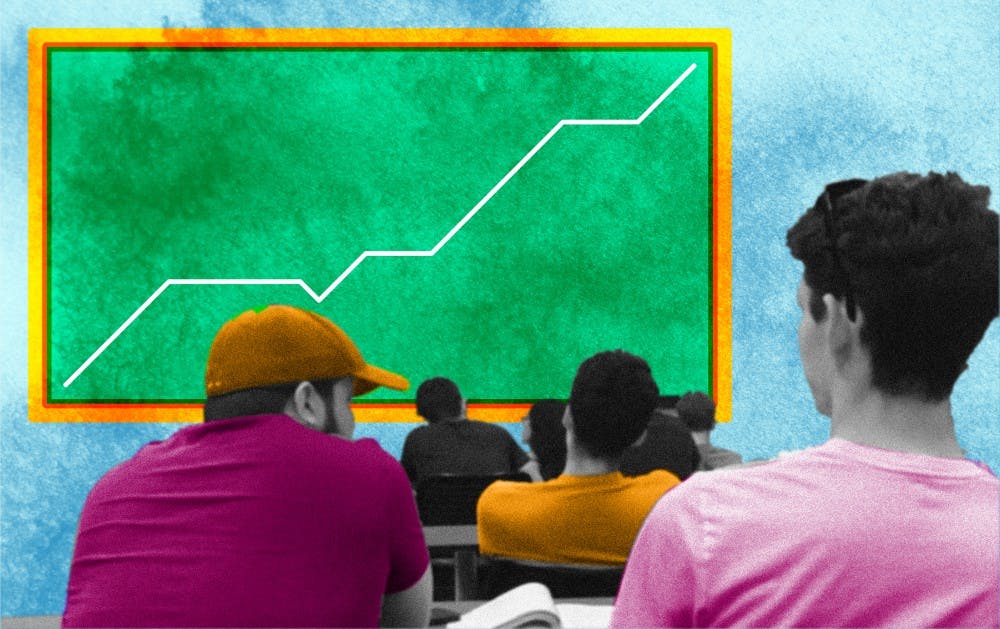For first-time freshmen, program changes can be frequent, but ASU has initiatives to keep students motivated to pursue majors they are passionate about.
University-wide initiatives such as eAdvisor and major map tracking help inform students of their academic progress and provide them the assistance they need for academic success. In addition to this, there is a new set of tools, internally referred to as the Student Success Suite initiative.
Since its implementation in 2015, overall retention rates for first-year freshmen have been growing at a steady rate, climbing closer to 90 percent retention in academic programs.
Although retention rates have fluctuated through the years, more recent initiatives involving more cohesive academic advising and on-campus involvement strategies show hope for steady growth in retention, controlling for the various factors influencing student success.
Especially with new programs in the School for the Future of Innovation and Society and the Thunderbird School of Global Management showing average retention rates around 90 percent, developing strategies since 2015 involving better academic advising and more strategies to get students involved on campus promise a future of higher program retention for ASU students.
“A student’s track status can actually change on any day,” executive director of Student Success Innovations Lisa McIntyre said. “So we were kind of taking time to look at that information, but the sort of thing that might have gotten in the student's way of being successful, it could have happened weeks before we pull that report.”
Once these initiatives have been implemented, students can view whether or not they are on track for their major any day after dropping or adding a class. Tools like these provide immediate assistance to students if they begin to fall behind in schoolwork.
However, what keeps students interested in their majors is not entirely the academic program itself. Another factor in student retention has to do with whether ASU students can call their campus “home.”
In 2017, the retention rate of on-campus freshmen was 2.6 percent higher than the average retention rate of 86.5 percent, while the retention rate of freshmen who lived off campus was 3.9 percent lower.
Phillip Scharf, assistant vice president of Educational Outreach and Student Services, said that on-campus students are more likely to be involved in academic and extracurricular programs.
“What we're trying to do is find ways that those students want to be on campus for a larger percentage of their time because we think that the more they're on campus, the more likely they are to retain more," he said. "They're off campus, the less connected they are to us, the less reason they would say.”
Students who do not feel connected to their program or school might consider getting involved with something outside of their classes, which is more of a challenge when life is split between on-campus organizations and an off-campus home.
"We want them to be engaged in something,” Scharf said. “So you can imagine if I'm off campus that becomes more difficult. When I go home, I'm not coming back for that club meeting.”
Although program retention is a goal of the University, its ultimate interest is helping each student find a program that is a good fit for them.
Tami Coronella, associate director of student academic services for the Ira A. Fulton Schools of Engineering, said the University offer resources for students still trying to figure out what kind of career they want to pursue.
“We have a robust set of tools here at ASU where students can explore what career might be right for them,” Coronella said. “We can introduce them to this tool called Me3, which walks you through a series of images and you pick the one that resonates most with you, and then it provides you with sort of a recommendation of an ASU major map that aligns with that.”
Ultimately, ASU strives to be more proactive about providing students the tools they need for academic excellence.
“Whatever that issue was, our ability to resolve the issue is much more effective,” McIntyre said. “That's really that idea of proactive advising and outreach, to help the students work through whatever it is that they're struggling with."
Reach the reporter at kalbal@asu.edu or follow @KarishmaAlbal on Twitter.
Like The State Press on Facebook and follow @statepress on Twitter.




